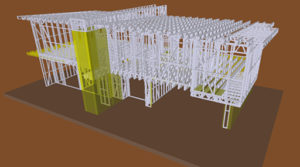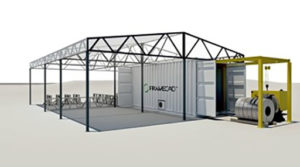 3D printed structures, like houses, office buildings, and bridges, are much more common than they were even a few years ago, and a construction company in Vancouver is introducing new disruptive technology that can accelerate the building process exponentially. Vancouver-based LifeTec Construction Group Inc. is working on several private projects with its technology, which can 3D print studs out of structural steel for home construction.
3D printed structures, like houses, office buildings, and bridges, are much more common than they were even a few years ago, and a construction company in Vancouver is introducing new disruptive technology that can accelerate the building process exponentially. Vancouver-based LifeTec Construction Group Inc. is working on several private projects with its technology, which can 3D print studs out of structural steel for home construction.
Most typical 3D printing processes for metallic materials, like steel, shape the material with lasers, which makes the printers get extremely hot, but LifeTec, which was founded earlier this year, uses the end-to-end design and build Framecad system, which is only available in New Zealand, South America, Europe, Australia, Asia, and Africa. The advanced Framecad allows for quality buildings to be constructed rapidly – this quality is very helpful now, as the Lower Mainland in Canada is currently going through a construction labor shortage.
“Right now, on any construction project in the Lower Mainland, time is a huge factor. When you are dealing with a lack of labour, speeding up those time frames creates huge efficiencies for any builder,” said LifeTec founder and president Krishna Jolliffe. “So I don’t think we’ll always be able to show people savings, because we aim to come in at the same cost as traditional methods, but on any project, we’ll have a significant time advantage.”
The company’s process is totally mechanical – instead of using specialized 3D printers to make individual modular parts, studs and panels, the building frame is designed on a computer. Then, the parts are shipped to the construction site and assembled there.
Jolliffe said, “There is no heat created whatsoever (in LifeTec’s process), which is a big part of our manufacturing value proposition. Any manufacturing process that creates high heat means a lot of energy is required; whereas our process consumes minimal amounts of energy.”
 Not only is 3D printed steel more durable, environmentally friendly, and resistant to warping and mold than wood, it offers shorter construction time. In terms of production-line steelmaking equipment, a single 3D printing machine takes up much less space.
Not only is 3D printed steel more durable, environmentally friendly, and resistant to warping and mold than wood, it offers shorter construction time. In terms of production-line steelmaking equipment, a single 3D printing machine takes up much less space.
“If we can work with the developer early enough, we can show up right when the foundation is complete, and it’s three to five days from there to assemble the house – as opposed to three to five weeks for building it from wood. Steel is just a way better product. If you look down the list … there’s just no doubt about what’s better in every category in terms of being a construction material,” said Jesse Goldman, LifeTec COO.
“The end goal is that I don’t want to see anything built out of wood anymore. This system of building in every other part of the world is huge. It’s just here, in this little pocket in the Pacific Northwest where you have so much access to lumber, that it’s not as big. But it doesn’t mean [Framecad steel] isn’t a better system; it’s just that people haven’t been give a reason to switch up to this point.”
Goldman believes that while it might take the rest of Metro Vancouver some time to learn how LifeTec’s innovative construction process works, it will be able to provide a quality, eco-friendly solution to the city in British Columbia that has an “acute need for housing.”
Jolliffe and LifeTec co-founder Mckinley Hlady are both construction pros, but only encountered 3D printed steel for the first time last year while they were in Florida working on a sustainable housing project – Jolliffe explained that 3D printed steel was used to make all of the structural building materials.
After the two founded the company and got to work, they introduced their team of builders to 3D printed construction techniques. Currently, LifeTec is only working on private detached homes, but the goal is to eventually work on larger construction projects, like multi-family residential and mid-rise commercial/industrial that are traditionally built from wood.
“The sky’s the limit. We can do anything that can be done with wood,” Jolliffe said. “The only construction we can’t do is for highrises, but we can still do all the infill framing. We can do that at the same cost of existing providers, but at three to four times the speed. So we can create efficiencies in practically every construction process going on in the market.”
 These larger projects really allow 3D printed steel to shine, because they “have a need for a higher level of uniformity across a bigger scale.”
These larger projects really allow 3D printed steel to shine, because they “have a need for a higher level of uniformity across a bigger scale.”
“People sometimes confuse us with steel-stud construction, which is like wood in that you cut all the pieces of the frames on site, and cutting steel takes longer than cutting wood, logically speaking. People worry about the cost associated with that,” Jolliffe explained.
“But with Framecad, everything’s printed beforehand, and the end cost to the consumer is usually the same as wood construction.”
According to company representatives, LifeTec has spoken with several local public organizations about taking on larger construction projects, and Jolliffe said that the company will soon outgrow its current space, which is only big enough for one 3D printer to manufacture steel modular parts; he hopes that within the next two years, LifeTec will have a full manufacturing facility with an office and three to four printing machines.
Discuss this and other 3D printing topics at 3DPrintBoard.com or share your thoughts in the Facebook comments below.
Subscribe to Our Email Newsletter
Stay up-to-date on all the latest news from the 3D printing industry and receive information and offers from third party vendors.
You May Also Like
NSF Awards Kentucky $1M for Advanced Manufacturing
The National Science Foundation has awarded a $1 million grant to the University of Louisville for the Advancing Manufacturing and Building Construction Technologies (NSF AMT) project. This initiative is part...
3D Printing News Briefs, May 11, 2024: 3D Printed Stent, Tower, Sculptures, & More
We’re starting off with medical research in today’s 3D Printing News Briefs, as researchers in Korea used CT images and 3D printing to fabricate an educational simulator for a mastoidectomy....
3D Printing Unpeeled: Wind Turbines, Probiotics and Lenses
TPI Composites, ORNL and Ingersoll Rand are working to make wind turbine tooling segments that can be 18.3 meters long. These elements also include resistive wires that help keep the...
Tethon 3D Releases Cost-effective Bioprinter
Tethon 3D, known for its ceramic-loaded DLP materials, custom resins, and DLP 3D printers, has recently released a bioprinter. Vat polymerization printers like DLP systems have been widely used by...



































